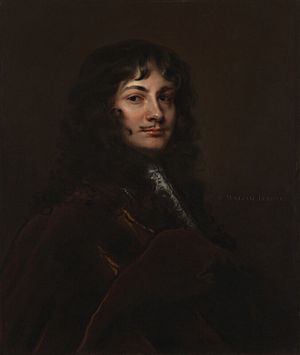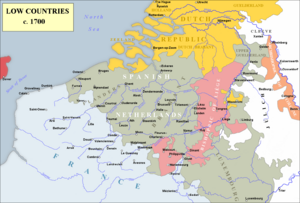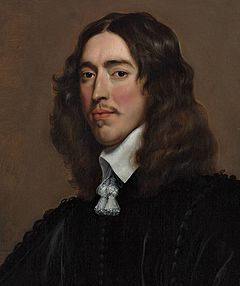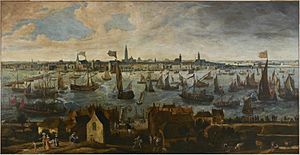Triple Alliance (1668) facts for kids

Sir William Temple, English ambassador in the Hague and driving force behind the Alliance
|
|
| Context | England, the Dutch Republic and Sweden agree a pact of mutual support |
|---|---|
| Signed | 23 January 1668 England, Dutch Republic 25 April 1668 Sweden |
| Location | The Hague 23 January 1668 London 5 May 1668 |
| Mediators | |
| Negotiators |
|
| Signatories |
|
| Parties | |
The Triple Alliance (also known as Trippelalliansen in Swedish) was an important agreement signed in May 1668. It brought together the Kingdom of England, the Swedish Empire, and the Dutch Republic. This alliance was formed because France had taken over parts of the Spanish Netherlands and Franche-Comté. Even though Spain and Emperor Leopold did not sign, they were very involved in the talks.
The Alliance had three main parts. First, it was a defensive agreement, meaning the countries would help each other if attacked. Second, it aimed to make Spain and France agree to peace. Third, it included secret plans. These plans involved helping to end the war between Spain and Portugal. They also planned to use military force if needed to make sure peace was kept.
Before this, in 1663, King Louis XIV of France realized that France and the Dutch Republic wanted different things in the Low Countries. So, he used the Second Anglo-Dutch War as a chance to start the War of Devolution in May 1667. King Louis and Emperor Leopold both had claims to the Spanish throne. In January 1668, they secretly agreed to divide the Spanish Empire if the Spanish king, Charles II, died without an heir. This agreement gave Louis the Spanish Netherlands and set the rules for the Treaty of Aix-la-Chapelle.
The Triple Alliance did not last long. Just four years later, both Sweden and England supported France in the Franco-Dutch War. However, this alliance was a turning point. It showed England and the Dutch Republic that France was becoming a common threat. This made the Triple Alliance a first step towards the Grand Alliance. The Grand Alliance later fought in the Nine Years' War (1688-1697) and the War of the Spanish Succession (1701-1714).
Contents
Why the Alliance Was Needed: The Background

The Treaty of the Pyrenees in 1659 ended the war between France and Spain. As part of this treaty, Louis XIV of France married Maria Theresa of Spain. She was the oldest daughter of Philip IV of Spain. Even though the Spanish Empire was weaker after many wars, it was still a huge global power. To stop France from taking over this empire, Maria Theresa gave up her right to inherit it. In return, Louis was promised a large payment of 500,000 gold coins, called écus. This huge sum was never paid.
In 1661, the French Finance Minister, Jean-Baptiste Colbert, believed France needed the Spanish Netherlands and the port of Antwerp to grow its economy. Taking these areas would give France control over its own trade. At the time, the Dutch Republic, a long-time ally, controlled much of this trade. However, this plan meant conflict with Spain, Emperor Leopold, and the Dutch. The Peace of Münster in 1648 made the Dutch independent from Spain. It also closed the Scheldt river estuary, which closed Antwerp's port. This made Amsterdam the richest trading city in North Western Europe. Keeping Antwerp closed was very important to the Dutch.
By 1663, King Louis realized the Dutch would not give him what he wanted peacefully. So, he started planning to take the area by force. France joined the Second Anglo-Dutch War in July 1665. This gave Louis a reason to make his army bigger. He also thought it would make it harder for the Dutch to stop him.
In September 1665, King Philip IV of Spain died. His four-year-old son, Charles II of Spain, became king. Philip's wife, Mariana of Austria, became the regent (ruler until the king was old enough). King Louis argued that since Maria Theresa's dowry was not paid, her decision to give up her inheritance rights was not valid. He claimed that her rights "devolved" (passed down) to him under an old law. This law, called Jus Devolutionis, said that only children from a first marriage could inherit. Louis used this to claim much of the Spanish Netherlands. In April 1666, Charles's sister, Margaret Theresa, married Emperor Leopold. This meant Leopold would inherit the entire Spanish Empire if Charles died.
Talks to end the Anglo-Dutch War began in Breda in May 1667. On May 24, Louis started the War of Devolution. By September, his troops had taken over much of the Spanish Netherlands. On May 27, the Treaty of Madrid ended the war between England and Spain. England agreed to help end the Portuguese Restoration War in return for trade benefits. The Dutch raid on the Medway in June forced England to agree to the Treaty of Breda on July 31. After this, England and the Dutch Republic started talking about working together against France.
How the Alliance Was Formed: The Negotiations

For Johan de Witt, a powerful Dutch leader, an alliance with France would help him stay in power. It would also ensure the Dutch kept their economic strength. By 1667, the idea of France becoming a powerful neighbor worried many Dutch people. Most of the States General of the Netherlands (the Dutch government) and the public saw an alliance with England as vital for their survival. England's King Charles II preferred France as an ally. However, he felt humiliated by the Treaty of Breda. He blamed Louis, who had not kept his promise to make the Dutch accept England's terms. Many of Charles's advisors, including Lord Arlington, agreed. They thought Spain would be a better ally than France. England had suffered from war and the Great Fire of London. So, both the Parliament and the City of London wanted peace. They believed partnering with the Dutch was the best way to achieve it.
The negotiations were led by Sir William Temple. He was the English ambassador in The Hague and Brussels. Temple believed French expansion was a bigger threat than Dutch economic power. He was supported by François-Paul de Lisola, an imperial diplomat. Lisola worked in London from 1667 to 1668 and in The Hague from 1669 to 1673. Historian Mark Goldie says Lisola's 1667 book, 'The Buckler of State and Justice', was important. It helped establish France as England's enemy, rather than Spain.
In September, De Witt asked Louis what he needed to withdraw from the Spanish Netherlands. He offered to help Spain accept Louis's terms. Louis agreed, but only if the Dutch forced both sides to accept them. Spain rejected Louis's terms. So, the States of Holland voted on December 10 and January 14, 1668, to support France militarily. On January 20, 1668, Louis and Leopold secretly agreed to divide the Spanish Empire if Charles died.
The French ambassador, Godefroi, Comte d'Estrades, knew a lot about the Alliance talks. He told Louis he could delay the agreement with bribes. However, Temple convinced the States General to approve the alliance quickly. This was before asking the local governments, which was the usual way. Once the States General announced their decision, the public was so excited that no one dared take d'Estrades' money. On January 23, 1668, England and the Dutch Republic signed the Alliance. Temple wanted to make the group bigger, so he invited Sweden to join. Sweden had signed a treaty with the Dutch in July 1667. Sweden also controlled the trade of pitch and timber from the Baltic Sea, which were vital for building ships.
What the Alliance Agreed: The Terms
The Triple Alliance had three main parts. First, it was a defensive alliance. Second, it guaranteed the terms for ending the War of Devolution. Third, it had secret clauses. Spain was partly blamed for the war because it arranged the 1666 marriage between Leopold and Margaret Theresa. So, Spain had to pay some of the costs. As agreed in September, France would leave the Spanish Netherlands. However, France would keep several cities, including Lille, Armentières, Bergues, Douai, Tournai, Oudenaarde, Kortrijk, Veurne, Binche, Charleroi, and Ath.
The Alliance promised to make Spain follow the rules. A secret clause required Spain to end its war with Portugal. King Louis was clearly getting ready for action. Another clause said that if France continued the war, the Alliance would force France back to its 1659 borders. The English Parliament approved £300,000 if needed. The Dutch government prepared 48 warships and planned to recruit 18,000 more soldiers. Sweden demanded 480,000 rixdollars to sign. This was for costs from its attempt to capture Bremen in 1666, which Sweden claimed helped Spain. The Dutch and English refused to pay. They passed the responsibility to Spain. After long discussions, Sweden signed on May 5. This brought together the three major powers in the Baltic and North Sea.
What Happened Next: The Aftermath
French troops entered Franche-Comté on February 5. Two weeks later, they had completely taken it over. King Louis then decided to make peace. The war had cost much more than he expected. Also, King Charles of Spain was reportedly close to death. If he died, Louis's secret agreement with Leopold meant he might get what he wanted without fighting. In April, Louis met with English and Dutch representatives at Saint Germain. They agreed on terms that were used at Aix-la-Chapelle in May. Article 6 stated that the Dutch and English would enforce these terms if Spain did not follow them. This was similar to the 'secret' clause of the alliance against France. In reality, England would not support a war with Spain for France or the Dutch. This was especially true given the trade terms of the 1667 Treaty of Madrid. Besides, the Royal Navy was not ready for a war.

Soon after, the Triple Alliance faced problems because the countries had different goals. De Witt and Charles saw it as a way to get a better deal with Louis. This was different from what most people in both countries thought, as they were strongly against France. Also, the English wanted peace, not necessarily to help the Dutch. Unsolved trade disagreements led to the Third Anglo-Dutch War. For Sweden, the Alliance was a chance to become the main Dutch ally in the Baltic. This would replace its rival, Denmark-Norway. It would also end the agreements forced on them by the 1656 Treaty of Elbing.
However, the treaty marked the end of the long-standing alliance between France and the Dutch. It was also the first step in creating a group of countries against France. This group continued until the end of the War of the Spanish Succession in 1714. The idea of a balance of power, supported by Temple, had two important effects on English policy. It meant England needed to be able to enforce this balance and have a network of allies. From 1668 to 1674, Parliament approved large amounts of money to make the Royal Navy stronger. English diplomacy also started to focus on countries like Sweden, Brandenburg, and Denmark, not just Spain, the Dutch, France, or the Holy Roman Empire.
De Witt hoped the threat of the Triple Alliance would make Louis less demanding. But it only showed how little control De Witt had over the States General. The Treaties of Breda and the Alliance were seen as great diplomatic successes for the Dutch. However, while De Witt understood the danger of stopping French plans, he could not convince his colleagues. Louis then decided the best way to get the Spanish Netherlands was to defeat the Dutch. He began preparing for the Franco-Dutch War (1672-1678).
Sources


